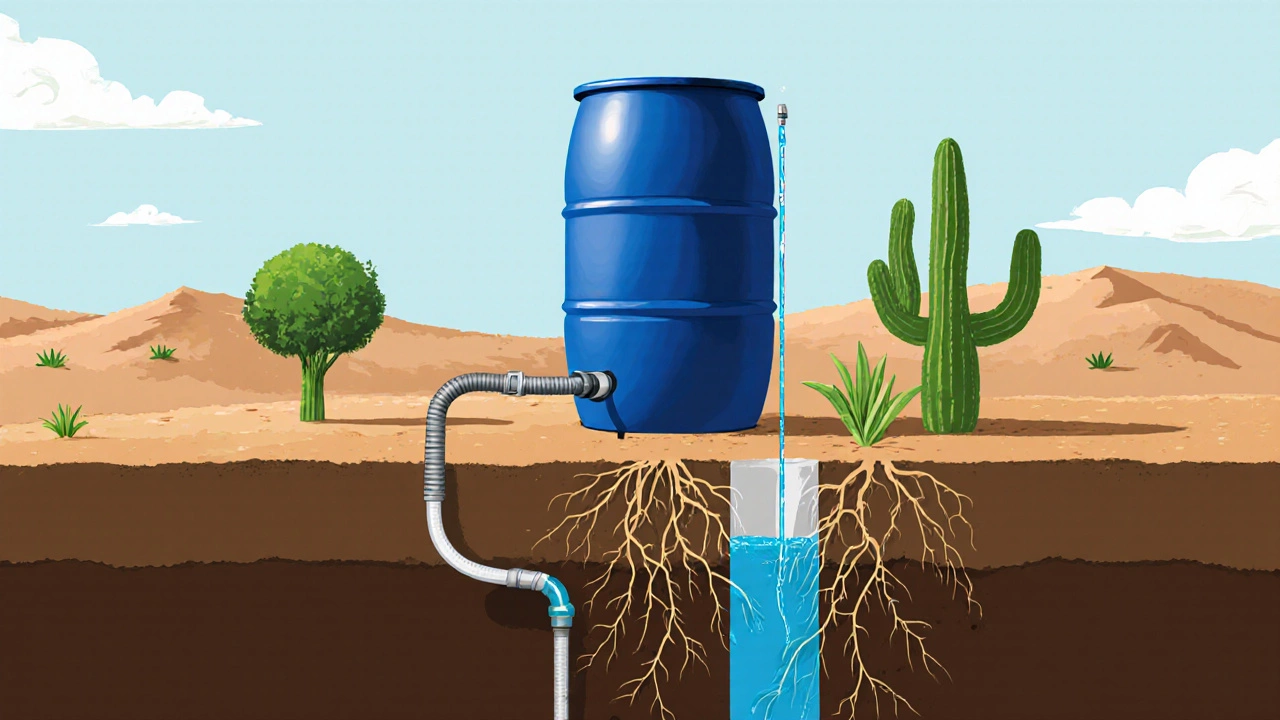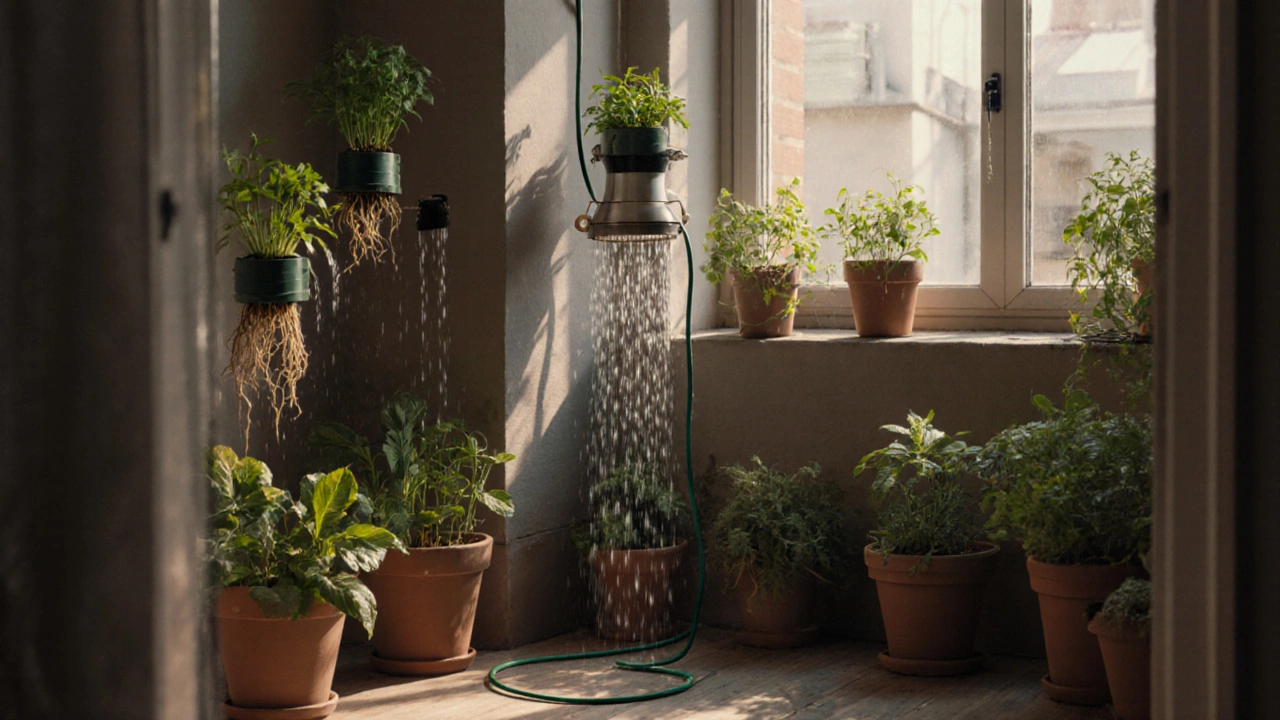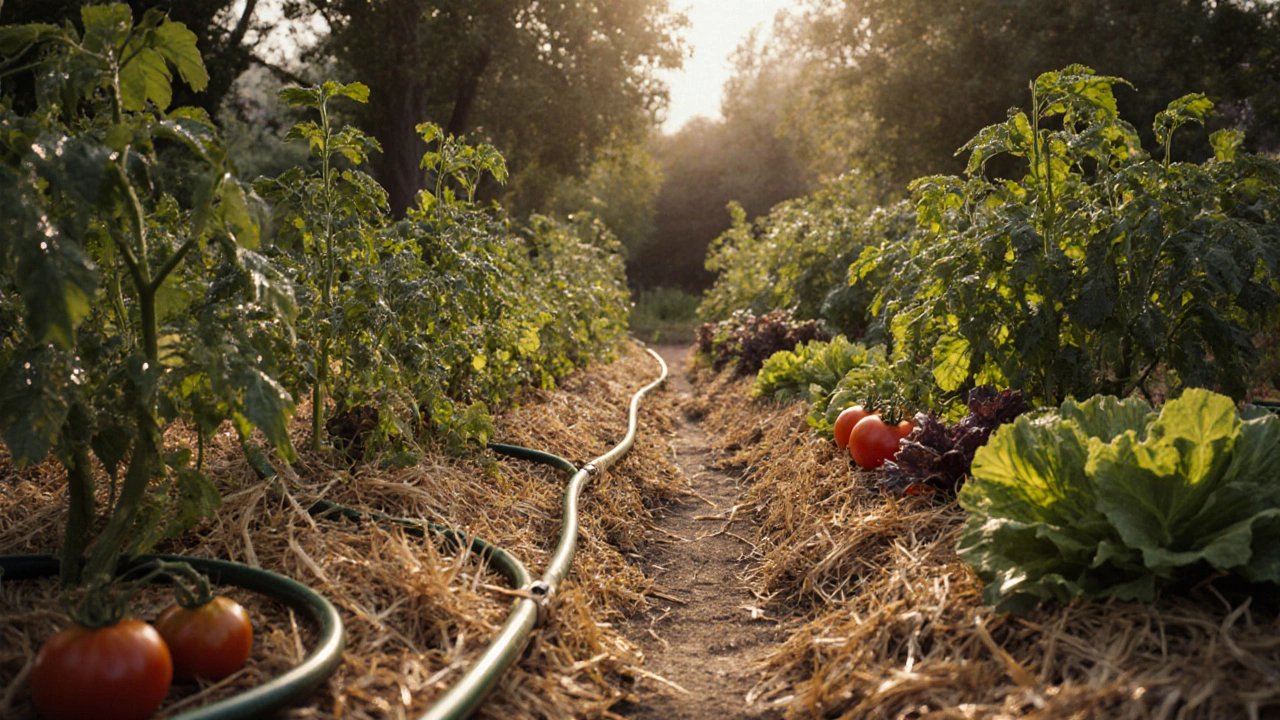Garden Water Efficiency Calculator
Calculate Your Water Savings
Find out how much water you could save by switching to more efficient garden irrigation methods
Your Estimated Savings
For years, drip irrigation has been the gold standard for saving water in gardens. It’s precise, efficient, and reduces evaporation. But if you’re looking to go even further - to cut water use even more, lower costs, or reduce maintenance - there are better options. Not because drip irrigation is bad, but because gardening technology and practices have evolved. Some methods outperform it in specific situations. Let’s break down what actually works better, depending on your soil, plants, climate, and goals.
Soaker Hoses Are Simpler and Often More Effective
Soaker hoses are basically drip irrigation’s low-tech cousin. They’re porous hoses that leak water slowly along their entire length. You lay them on top of the soil, cover them with mulch, and turn them on. No emitters to clog. No pressure regulators needed. No complex tubing layouts.
Here’s the catch: in clay soil or on slopes, drip systems can leave dry spots because water doesn’t spread far from each emitter. Soaker hoses? They water a continuous band. A 50-foot soaker hose can evenly moisten a 4-foot-wide row of tomatoes, carrots, or lettuce - no gaps. In a 2024 field trial by the University of California Cooperative Extension, soaker hoses used 18% less water than drip systems over a 12-week growing season for vegetable beds, while yielding the same or higher crop output.
They’re also cheaper. A 50-foot soaker hose costs under $20. A comparable drip kit with tubing, emitters, filters, and timers runs $60-$100. And if you forget to turn it off? Soaker hoses don’t flood. They just stop leaking.
Mulching Isn’t Just a Bonus - It’s the Real Water Saver
Here’s something most people miss: drip irrigation and soaker hoses are useless without mulch. Watering the soil is only half the battle. The other half is keeping it from drying out.
Organic mulch - wood chips, straw, shredded leaves - cuts evaporation by up to 70%. A 3-inch layer of mulch over a drip-irrigated bed can reduce watering needs by nearly half. In hot, dry climates like Arizona or Southern California, gardeners who skip mulch end up running drip systems 2-3 times a day. Those who use mulch? They water once every 3-4 days.
One gardener in Nevada tracked her water use for two years. In Year 1, she used drip irrigation without mulch. She used 8,000 gallons. In Year 2, she added 4 inches of composted bark mulch and kept the same drip system. Her usage dropped to 3,200 gallons. That’s a 60% cut - just from mulch.
Mulch also suppresses weeds, feeds the soil, and keeps roots cool. It’s not a side effect. It’s the main event.
Rainwater Harvesting Beats Any Irrigation System
If you want to eliminate your water bill entirely, drip irrigation won’t do it. Rainwater harvesting will.
Install a 500-gallon rain barrel under your downspout. Add a simple filter and a spigot. In most temperate climates, you can collect 600-1,000 gallons from a single heavy rain on a standard roof. That’s enough to water a 200-square-foot vegetable garden for a full month.
Combine it with a gravity-fed soaker hose system. No pump. No electricity. No cost. In a 2023 study by the National Renewable Energy Laboratory, households using rainwater harvesting for garden irrigation reduced municipal water use by 85% during the growing season. That’s better than any drip system alone.
And it’s not just for big homes. Even apartment balconies can use small rain catchers - 20-gallon bins under window ledges - to water potted herbs and flowers. No tap water needed.

Subsurface Irrigation Is the Future (And It’s Already Here)
What if you could water plants from below - without ever seeing the water? That’s subsurface irrigation. It’s like drip irrigation, but the tubes go 6-12 inches underground. Water seeps directly into the root zone. No evaporation. No runoff. No wet leaves to invite fungal diseases.
It’s used in commercial farms and high-end landscapes, but it’s becoming affordable for home gardeners. Systems like the WaterBob or Subsurface Drip Irrigation (SDI) kits now cost under $100 for a 100-square-foot garden.
Compared to surface drip, subsurface irrigation uses 30-50% less water. Why? Because surface drip loses water to wind, sun, and evaporation - even if it’s slow. Subsurface? It’s hidden. It’s quiet. It’s invisible.
And it’s perfect for drought-prone areas. In Arizona, a community garden switched from surface drip to subsurface and cut water use by 47% in one season - while increasing yields. The plants didn’t know they were being watered. They just grew better.
Hydroponics and Aeroponics for High-Density Spaces
If you’re growing in containers, on balconies, or in small urban plots, traditional soil-based irrigation is inefficient. Soil holds water, but it also wastes it. Hydroponics and aeroponics recycle water constantly.
In a closed-loop hydroponic system, plants grow in nutrient-rich water. The same water is reused over and over. A single system can grow 20 lettuce plants using less than 10 gallons a week - less than what a single tomato plant needs in soil.
Aeroponics is even more extreme. Roots hang in air and get misted with nutrients for 2-5 minutes every hour. Water use? Less than 5% of traditional gardening. NASA uses it for space stations. You can use it on your apartment windowsill.
It’s not for everyone. It needs electricity, monitoring, and a bit of tech comfort. But if you’re serious about growing maximum food with minimum water, this is the ultimate upgrade.

Combining Methods Is the Real Secret
The best gardeners don’t pick one system. They stack them.
Example: In a backyard vegetable plot, they use:
- Subsurface drip tubes under each row of deep-rooted crops (tomatoes, peppers)
- Soaker hoses for shallow-rooted plants (lettuce, radishes)
- 3 inches of straw mulch over everything
- A rain barrel feeding the entire system
They water only once a week - even in 90°F heat. No electricity. No pressure pumps. No clogged emitters. No wasted water.
This combo uses 70% less water than a standard drip system alone. And it’s more reliable. If one part fails, the others still work.
What to Avoid
Don’t fall for the myth that “more water = better plants.” Most gardeners overwater because they’re afraid of drying out their plants. But plants adapt. They grow deeper roots when they’re not constantly fed.
Also, avoid plastic drip systems in cold climates. They crack in freezing temps. Soaker hoses and mulch are more forgiving.
And never install drip irrigation without a filter. Even city water has sand and sediment. Clogged emitters mean dry plants - and frustration.
Final Answer: What’s Better Than Drip Irrigation?
There’s no single winner. But here’s what beats drip irrigation in real-world use:
- For simplicity and even coverage: Soaker hoses with mulch
- For zero water bills: Rainwater harvesting
- For maximum water savings: Subsurface irrigation
- For space-limited gardening: Hydroponics or aeroponics
- For long-term resilience: Combining all four
Drip irrigation isn’t obsolete. But it’s no longer the best option - not when you can do better with less effort and less cost.
Is drip irrigation still worth using?
Yes - but only if you’re in a dry climate with deep-rooted plants and you’re willing to maintain it. Drip works well for orchards, vineyards, and large raised beds. But for most home gardens, simpler, cheaper, and more efficient options exist. If your drip system is old, clogged, or requires constant tweaking, it’s time to upgrade.
Can I use soaker hoses with a timer?
Absolutely. Soaker hoses work perfectly with basic outdoor timers. Set it for 1-2 hours once or twice a week, depending on your climate. No need for fancy controllers. A $15 hose timer from any hardware store will do the job.
Does mulch attract pests or termites?
Only if you use fresh wood chips or bark near your house foundation. For garden beds, use composted mulch or straw. These don’t attract termites. In fact, mulch encourages beneficial insects and fungi that help break down organic matter and protect plants. Keep mulch 6 inches away from your home’s walls, and you’re fine.
How do I know if my plants need less water?
Stick your finger 2 inches into the soil. If it’s damp, don’t water. Wait. Most plants thrive on dry spells between waterings. Wilting in the afternoon is normal in hot weather. If plants recover by morning, they’re fine. Constant watering weakens roots.
Are hydroponic systems hard to maintain?
Not if you start small. A $50 countertop hydroponic kit for herbs like basil and mint requires just topping off the water every 10 days and adding nutrients monthly. It’s easier than potting soil. No weeding. No soil bugs. Just clean, fast growth.

